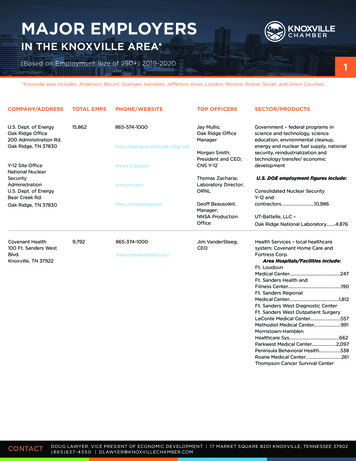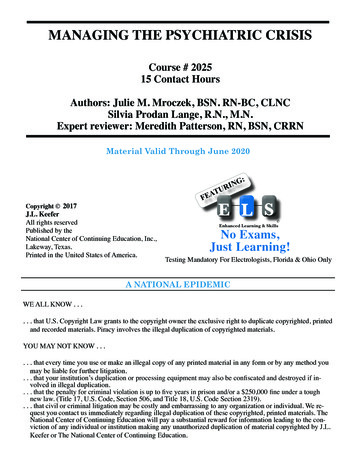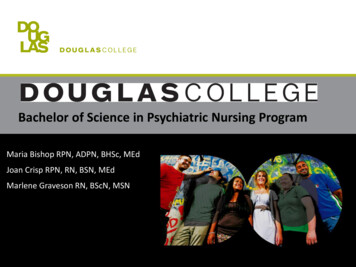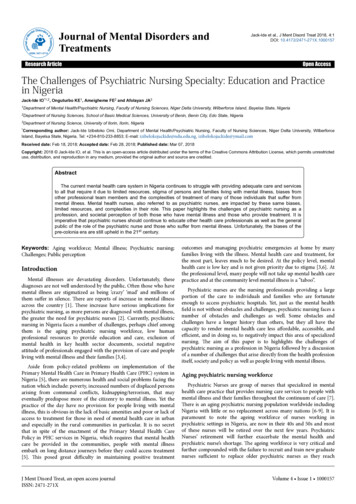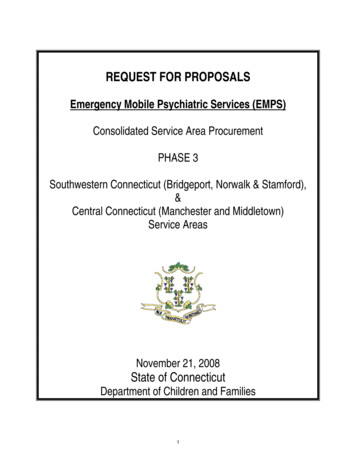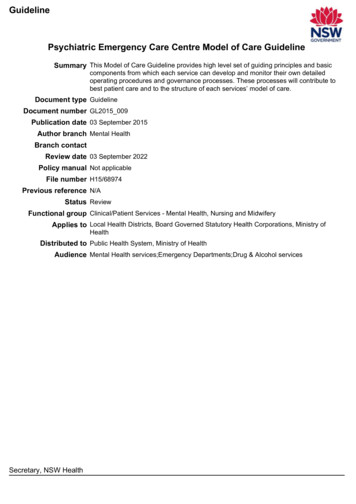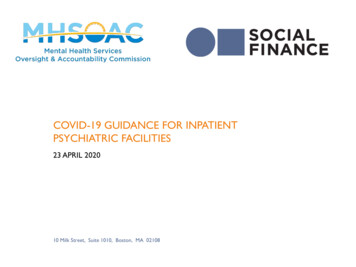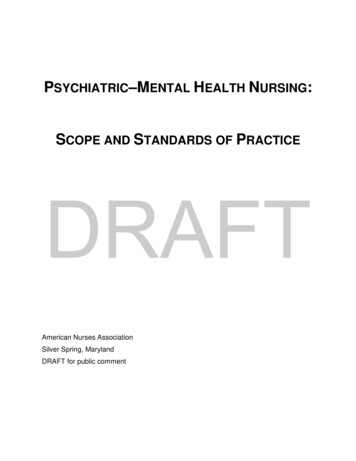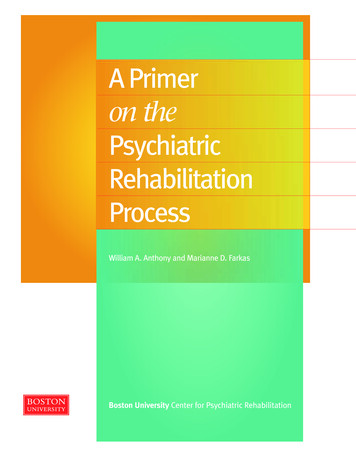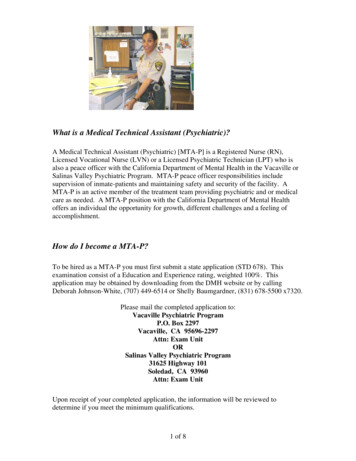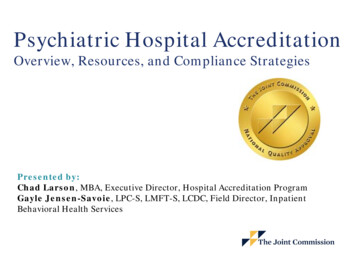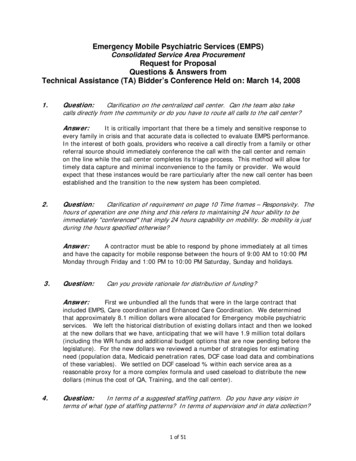
Transcription
Emergency Mobile Psychiatric Services (EMPS)Consolidated Service Area ProcurementRequest for ProposalQuestions & Answers fromTechnical Assistance (TA) Bidder’s Conference Held on: March 14, 20081.Question:Clarification on the centralized call center. Can the team also takecalls directly from the community or do you have to route all calls to the call center?Answer:It is critically important that there be a timely and sensitive response toevery family in crisis and that accurate data is collected to evaluate EMPS performance.In the interest of both goals, providers who receive a call directly from a family or otherreferral source should immediately conference the call with the call center and remainon the line while the call center completes its triage process. This method will allow fortimely data capture and minimal inconvenience to the family or provider. We wouldexpect that these instances would be rare particularly after the new call center has beenestablished and the transition to the new system has been completed.2.Question:Clarification of requirement on page 10 Time frames – Responsivity. Thehours of operation are one thing and this refers to maintaining 24 hour ability to beimmediately "conferenced" that imply 24 hours capability on mobility. So mobility is justduring the hours specified otherwise?Answer:A contractor must be able to respond by phone immediately at all timesand have the capacity for mobile response between the hours of 9:00 AM to 10:00 PMMonday through Friday and 1:00 PM to 10:00 PM Saturday, Sunday and holidays.3.Question:Can you provide rationale for distribution of funding?Answer:First we unbundled all the funds that were in the large contract thatincluded EMPS, Care coordination and Enhanced Care Coordination. We determinedthat approximately 8.1 million dollars were allocated for Emergency mobile psychiatricservices. We left the historical distribution of existing dollars intact and then we lookedat the new dollars that we have, anticipating that we will have 1.9 million total dollars(including the WR funds and additional budget options that are now pending before thelegislature). For the new dollars we reviewed a number of strategies for estimatingneed (population data, Medicaid penetration rates, DCF case load data and combinationsof these variables). We settled on DCF caseload % within each service area as areasonable proxy for a more complex formula and used caseload to distribute the newdollars (minus the cost of QA, Training, and the call center).4.Question:In terms of a suggested staffing pattern. Do you have any vision interms of what type of staffing patterns? In terms of supervision and in data collection?1 of 51
Answer:5.6.We are looking to see what you propose. We are trying to offer flexibilitywithin the parameters that are outlined in the RFP and repeated below.Your proposed staffing plan should be sufficient to effectively deliver theservice as described. Your proposal will be evaluated, in part, based onyour proposed staffing model. (See Staffing and Team compositionsection of the RFP)Question:In terms of the 90 percent mobility. If you have family who you haveoffered to go out and they don’t want you to go out. You have used all your persuasiveskills to have them let you come out and they still say no. How is that going to betracked?Answer:It is still going to be considered a non mobile response. That mayhappen, but our expectations are that 90% of the time is a mobileresponse.Question:home kids?In terms of the eligible children. Clarification does that include groupAnswer:Yes, EMPS providers must respond to all calls that come in to it, includingcalls regarding children in community based group homes.Note: However, it is the expectation that therapeutic group homes willhave staff with the knowledge, skills, experience, and training to respondto the needs of children in their care in most instances without assistancefrom EMPS. If mobile crisis teams do respond it is expected theywill do so in accordance with any practice or policy adjustmentsmade pursuant to a review and analysis of: 1) the volume of calls toEMPS from group home settings; 2) the impact of EMPS intervention ingroup homes (as a group and individual homes) on police and EDutilization by group home clients, and; 3) the continued capacity of EMPSproviders to respond appropriately to other crises in the community.Adjustments to policy and practice will take into account feedback fromgroup home and EMPS providers7.Question:On page 15, it talks about letters of agreement. Are there anymandatory letters of agreement? There was a talk about an MOU.Answer:There are no mandatory letters of agreement or MOUs. We are onlylooking for tangible agreements; services that your agency and another provider agreeto do that do not involve the exchange of money. If you give money to someone thatmeans it is a sub-contract. If you have protocols for working with other providers inthe community, such as schools or EDs, you should include them in this section.2 of 51
8.Question:The 45 minute mobility piece, obviously looking at the entire EasternRegion of Connecticut. You could be two hours away from somewhere.Answer:9.Question:Do we need to put money in the budget for marketing? You talkedabout having a state wide marketing policy.Answer:10Yes. I think there is a distinction between local outreach and state-widemarketing. We are going to be responsible to produce marketingmaterials for statewide access including potentially some things such asTV spots or advertisements. Each provider will still need to do localoutreach to schools, clinics, police, and other potential referral sources.You still need to do that, but DCF will provide materials in support of thiseffort.Question:In terms of training monies, there is going to be some state-widetraining, but we have some responsibility for that.Answer:11.We understand this question to raise the concern about being able tosatisfy the 45 minute rule uniformly. In answering this, we must firstpoint out that meeting this standard depends on where you locate yourstaff. The plan you submit should demonstrate how you will effectuate a45 minute mobile response, including utilizing all means permitted per theRFP.Question:Yes; although the state will fund some of the training costs, the providerwill be responsible for funding and providing training in the first year ofthe contract per the RFP (see pages 11 and 13). Costs associated withthis should be put in your budget. The department will provide furtherguidance to providers to whom contracts are awarded.We don’t have to budget for the call center?Answer: No, you do not have to budget for a call center. However, you have to havesome way that your staff will be immediately available to take calls from the call center24-7 and be able to be connected to accept the case.12.Question:areas?I have a question in regards to sub-contracting. How do you define sub-Answer:The RFP clarifies that if you have a subcontract for training or for datamanagement that is fine. If you carve out some subset of towns to sub-contractcoverage with another provider, then that is a sub-contract for a sub-area. You need toprovide evidence supporting why sub-contracting a sub-area of the service area is a3 of 51
better way to provide the service than doing it all under one contract. Sub-contracts arenot encouraged, but will be acceptable if shown to improve quality and to ensureprogram requirements are met.13.Question:Could part of that be letters of agreement that the subcontractor has withschools, police and communities already?Answer: Yes. You need to provide evidence as to why providing the service under asubcontract is going to be better than not. Whatever evidence you believe supports thatargument, you should present.14.Question:area?Could you provide the data of numbers of EMPS calls in each existingAnswer:The data on call volume is not available by DCF area office. We areproviding the call volume by each of the established service areas. *Please note thatdue to various issues with data submission, call definition, existing call systems andother practice and technical factors, this data may not reflect actual call volumes and issubject to underestimation of call volumes. We expect call volume under the newsystem to be considerably higher.Service AreaGreater HartfordEastern Connecticut15.Question:Could you describe a little bit in more detail what 211 triage would bewhether it is in a crisis or not?Answer:16.Annual Call Volume1,892585It is important to note at the outset that contract negotiations with thecall center are still underway. It’s our intention to have them perform aclinical triage function during the hours of mobility. During the hours ofmobility they will be making a determination about whether this requiresa mobile response, police right away, have the child taken to theemergency room, or that this is an information and referral inquiry only.The call center will make some of those initial judgments then contact theEMPS provider in the appropriate area that is required to respond.Question: In the current contracts there are positions that are defined. You talkabout carving in service effectiveness coordinators and carving out intensive caremanagers. Can you say more about that?Answer:In our effort to separate out the cost centers for EMPS, CareCoordination, and Enhanced Care Coordination, we tried to equitably distribute these4 of 51
resources that have sometimes been shared across programs. This has been difficult asthese positions have migrated and been utilized differently be each provider.17.Question: I just would like clarification about the carve in/carve out of the serviceeffectiveness coordinator position.Answer:The previous discussion was regarding where the dollars associated withthese positions landed in our effort to determine how much money was available forEMPS. We haven't specified a specific staffing plan in the RFP except that you musthave licensed or licensed eligible staff, access to sufficient psychiatry time, and ability tofulfill all the expectations outlined within the RFP. We are purposely leaving flexibilityregarding the staffing.18.Question: Does the provider who is responsible for the mobile response have thefinal decision regarding staff safety? You had said the call center would determinemobility?Answer:19.Question:Question regarding the targeted population. You specifically mentionabout HUSKY A/B and you know a lot of kids with commercial insurance are also beingreferred, do you expect us to continue to do that?Answer:20.Yes, the provider makes the final decision regarding staff and clientsafety and the appropriateness of a mobile response. The Call Centerwill make the determination about which calls require a mobile response.The provider may decide that it is not safe to send someone out, or thesituation may change between the time that the call center makes itsassessment and the EMPS provider goes out. However, we will betracking all calls, including those not deemed to require a mobileresponse. A minimum of 90% of calls referred to the provider by the callcenter must result in a face-to-face mobile intervention.YesQuestion:Question regarding 90% immediate mobility - if we have a call from theschool and we speak to the parent and the parent says " I am at work and I would likeyou to come to the house at 5 o'clock when I get out of work." It sounds like thatwould be okay but that doesn't counts as immediate mobile response knowing that thechild is safe.Answer:We are looking for a response in 45 minutes. If somebody can wait five to 10hours, it is not likely a crisis that requires mobile response. That is something that you couldrefer to the Enhanced Care Clinic locally to handle. Please also see response to 50 below.5 of 51
21.Question:Currently our team is compromised of clinicians and case manager and insome of the recommendations they talked about advocates and I was hoping you couldspeak to that.Answer:This is an area where we would like to allow some flexibility. Ourexpectation is that the person who is going out doing initial assessment and makingimportant clinical judgments about what the crisis plan should be, what resources areneeded, and whether the child should remain at home; that needs to be a clinicalperson. You may decide in your program that the follow-up care is best handled by apeer/advocate/paraprofessional and you believe that you can implement that modelwithin the budget that we have provided. If that is the case, you should propose thatkind of model, how it would work, and why it is better than other models. You need toensure that the initial crisis response is done by a clinically trained person with thecredentials outlined in the RFP and that the overall staffing plan allows you to provide allaspects of the program in the most cost effective manner.22.Question:Beyond 6 weeks - Request permission? To whom?Answer:Requests for permission should be directed to the assigned DCFmanager of EMPS. Please note that while DCF believes follow-up care iscritical, it is vital that providers maintain a balance between maintainingcapacity for mobile response to initial crises and providing sufficientfollow-up care to support continued stabilization and linkage.23.Question:transfers.I am a little concerned about the technology of the 211 calls andAnswer:We are looking at that right now to determine what will be required. Aswe go further along with the discussion with 211 and determine that there is a certainpiece of technology that will assist in this being effective, we would allow that as astartup expense.24Question:Answer:25.Can we use start up funds for capital expenses?Yes, remember the capital limit for state is 5000.00Question:Are you requiring that these people be on staff in whatever the locationis up to those hours?Answer:There has to be a number that staff can be reached at and wherethe call center could reach them. You just have to be able to take that call. Theperson has to be 100% available to respond either in person or by phone.6 of 51
26.Question:Materials?Can you tell me the reference for the Grealish Crisis Intervention PlanningAnswer:The materials can be located atwww.crisisplanningsolutions.com or at 727-941-9454.Questions received via e-mail27.Question:Answer:Can you provide a list of who has submitted letters of intent by area?Eastern CTUnited ServicesUCFSCommunity Health ResourcesHartford areaVillageWheelerRushfordCommunity Health Resources28.Question:What are the existing EMPS budgets (minus the care coordination, etc.)for the current geographical configurations?Answer:The existing dollar amounts are listed in the table below.AreaSouthwest (Stamford, Norwalk, Bridgeport)Western CT (Waterbury, Danbury,Torrington)Greater Hartford (Hartford, New Britain, &Meriden)New Haven (Greater & Metro NH)Central (Manchester & Middletown)Eastern (Norwich & Willimantic)Total29.Existing Dollars 1,505,741 1,447,239 1,946,908 1,433,120 821,385 947,355 8,101,748Question:Does the EMPS have to accept all calls referred from the call center? Arethere any exceptions if the answer is yes?Answer:Yes, the EMPS provider must accept all calls from the call center thatrequire a response and originate from or require a response within the defined servicearea. All calls must be responded to.7 of 51
30.Question:Who has the ultimate choice regarding mobility of the team?Answer:The ultimate decision-making authority regarding the nature of theresponse to a call rests with the mobile response team.31.Question:What is the anticipated start date for the Central Service area?Answer:The Central Service area is not part of this current procurement.Following a separate procurement process under phase III we anticipate startupinitiating in January 09 and "go-live" sometime in the middle to end of March of 09.32.Question:How will the centralized call center be rolled out?Answer:The state is currently in negotiations with the proposed call centerprovider. We are planning for an initial implementation date in July of 08 to serve theEast and Greater Hartford Areas. Further details regarding the roll-out across the rest ofthe state are pending the current contract negotiations.33.Question:If a client calls directly to an agency requesting crisis services, does theagency have to refer them to the centralized call center or can they just accept the calland proceed?Answer:34.Question:Will there be an “any door in“ practice or do all calls have to be routedthrough the centralized call center?Answer:35.See question 1 aboveSee question 1 aboveQuestion:If a subcontractor will provide some of the direct EMPS response to adefined geographical area, do you want any more detailed information about them thanwhat is on the subcontractor form?Answer:Yes. You should elaborate in the body of your response on thequalifications of the subcontractor.36.Question:With regard to the 45 minute response time- Will/can a longer timeframeexist for the ED discharges? More times than not, the hospital is calling hours beforethe child is even discharged and then the family wants to meet the next day or evenwithin two days. These are very different referrals because the child is not in crisiswhen they call and the family has trouble tolerating all this evaluation back to back.Answer:We expect the same availability for a 45 minute response to the ED as wedo for response in other community settings. The response need not involve anextensive evaluation that is redundant with the evaluation that just occurred in the ED.The primary purposes of the ED follow-out are to help facilitate a more timely dischargefrom the ED, assist in the development of a crisis plan to prevent or diminishsubsequent crises, and establish initial contact and establishment of rapport. In some8 of 51
cases all that may be required is a brief contact to introduce a member of the team andestablish a follow-up appointment. However, every effort should be made to make theinitial contact, in person, in as timely a manner as possible.37.Question:Based upon Dr. Plant's discussion of the subcontractor issue at thetechnical assistance, if the applicant can show that the use of sub-contractors improvesthe quality of this service, for instance if we are successful current EMPS providersthrough subcontracts, can show we are able to respond better to local needs, havebetter ability to provide same day psychiatric care and are the current ECC providers forthe sub-regions as well, then DCF is fine with an applicant having subcontractors?Answer:38.See question 12 above.Question:In other words, do we lose points, just by virtue of applying withsubcontractors?Answer:No specific points are assigned to the ability to provide services withoutsubcontractors. That will be considered as part of the scoring on the bidderqualifications.39.Question:Can you please expand on the “Statement on Sub-contracting” as itpertains to service delivery. Specifically what points are subtracted from a bid thatelects to use subcontractors?Answer:40.See question 38 above.Question:Could contracts be amended after execution to add a subcontractor iffound to be necessary?Answer:Yes, but any amendments to add subcontracts must be approved inadvance by DCF prior to implementation.41.Question:What evidence is the department looking for to validate the need ofsubcontractors?Answer:The applicant will need to demonstrate how the use of a subcontractorwill improve upon their ability to deliver the required aspects of the EMPS modeldescribed in the RFP.42.43.Question:What is the timeline for the development of the centralized call center?Answer:See question 31 and 32 above.Question:What data will be used to calculate the 90% mobility requirement? Whatif a family refuses to have clinicians in their home?Answer:See question 5 above.9 of 51
44.45.Question:What is the process for an exemption to the follow-up limit of six weeks?Answer:See question 22 above.Question:Do the formatting guidelines for font size (12pt) and spacing (doublespaced) apply to graphs, charts and tables?Answer:46.No, they do not.Question:Do all appendix pages need to be numbered? If we are to number theappendix pages, can we number the pages of each appendix separately? (For example,Appendix 1 - page number through Appendix 10 - page number.)Answer:We prefer that all pages be numbered consecutively, regardless of theirsection in the application. Hand-numbering is fine47.48.49.Question:What is the current level of funding for EMPS in each DCF Area?Answer:See question 28 above.Question:What is the EMPS service volume for each DCF Area Office?Answer:See question 14 above.Question:In the RFP, under hours of operation, the last bullet states “during thehours of 10pm-9am Mon.-Friday and 10pm-1pm on Saturday, Sunday and holidays, theEMPS contractor must respond immediately by phone, or in person, to all callsrequiring crisis I intervention”. At the bidders conference a similar questions was askedwith regard to the requirement of in person response during these hours and the answerwas there was no requirement for in person response. Is the in person responserequired or not during these hours?Answer:In person, mobile, or face-to-face response is not required but is optionalduring the hours of 10PM to 9AM Monday through Friday and 10PM to 1PM onSaturdays, Sundays and Holidays. An immediate telephonic response is required duringthese hours.50.Question:Regarding the 45 minute response time requirement- often a school willcall for assistance, our team will contact the parent to arrange an immediateintervention and the parent will request a later time that day ( i.e. due to work schedule,etc.) – the answer at the bidders conference was to refer that family to an ECC forurgent care if they could wait. However this approach removes the possibility of amobile assessment which may be indicated. How should these calls be handled? Willthere be room for exceptions to the 45 minute rule to accommodate this situation?Answer:We assume your question pertains to the 45 minute rule. There is adegree of clinical judgment that must be exercised in such situations. Our expectationof a 45 minute response is applicable to most situations but there may be some10 of 51
exceptions. Our preference is that you are on the scene, as soon as possible, within 45minutes and that the overwhelming majority of cases conform to this timeframe. In thecase of the parent who wishes to come later, after work, it may be appropriate to obtainfaxed or verbal consent to treat and begin intervention with the child and schoolpersonnel before the parent arrives and/or a request may be made of the parent thatshe get to the school ASAP considering the nature of the crisis.51.Question:Page 12 of the RFP notes that EMPS providers must work to establishrelationships with each school system within their service area. What responsibility, ifany, will the successful applicant have in providing actual EMPS services in schooldistricts?Answer:Schools are one of the primary sources of referral to EMPS and providersare expected to provide on-site EMPS services within school settings. A furtherexpectation of the EMPS service is that providers identify and seek to remove anybarriers, real or imagined, to effective EMPS service in school settings. Such barriersmay include difficulties regarding obtaining parental consent for treatment, lack ofparental presence in the school setting, or other school, family, or program basedbarriers. Strategies may include efforts to obtain consent/preauthorization fromguardians for EMPS intervention for all children, or those with behavioral plans who areat greatest risk of requiring crisis intervention services.Question:One provider and the DCF multi-cultural advisory committee providedfeedback on the language used to allow an exception on acceptable credentials forbilingual/bicultural clinicians. They object to the potential creation of a double standardwhereby those whose preferred language is not English may receive service that is unequal fromthat provided to those whose preferred language is English.52.Answer:As a result we are making the following change in the language thatappears on page 11, top of the page, under the section entitled staffing and teamcomposition,4th bullet, last sentence. The corrected sentence should read"Exceptions to these clinician credentialing requirements may be allowedwith prior approval from DCF."53.Question:Will DCF be explicit about the data components to be collected andanalyzed and assure that these components are feasible, reasonable and useful?Answer:Yes, DCF will outline the data components based on its work with the QIand Training vendor and with each selected provider through contract development.End of Questions and Answers11 of 51
REQUEST FOR PROPOSALSEmergency Mobile Psychiatric Services (EMPS)Consolidated Service Area ProcurementPHASE 1Greater Hartford (Hartford, New Britain, & Meriden), &Eastern Connecticut (Norwich & Willimantic)Service AreasMarch 7, 2008State of ConnecticutDepartment of Children and Families12 of 51
TABLE OF CONTENTSPROGRAM TITLE. 4PROCUREMENT SCHEDULE . 4OVERVIEW. 4SOURCE OF FUNDS . 5AMOUNT AND TERMS OF AWARD. 6PERIOD OF AWARD. 6DISPOSITION OF PROPOSALS. 6ELIGIBILITY. 6INSURANCE. 6APPLICATION DEADLINE . 7TECHNICAL ASSISTANCE / BIDDERS CONFERENCE. 7LETTER OF INTENT . 7RFP CONTACT PERSON . 7QUESTIONS. 8PURPOSE AND GOALS . 8TARGET POPULATION . 8MODEL DESCRIPTION. 9MULTICULTURAL AND LINGUISTICALLY COMPETENT TRAINING AND CARE . 13APPLICANT QUALIFICATIONS. 13APPLICATION INSTRUCTIONS AND REVIEW INFORMATION . 13APPLICATION FORMAT. 14APPENDICES. 14REVIEW CONTEXT. 15REVIEW PROCEDURES . 15PREPARING A RESPONSIVE APPLICATION . 1713 of 51
APPLICATION QUESTIONS. 18BUDGET FORMS . . 20LETTER OF INTENT .
included EMPS, Care coordination and Enhanced Care Coordination. We determined that approximately 8.1 million dollars were allocated for Emergency mobile psychiatric services. We left the historical distribution of existing dollars intact and then we looked at the new dollars that we have, anticipating that we will have 1.9 million total dollars
